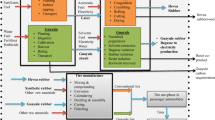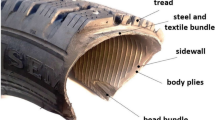Abstract
Purpose
The number of scrap tires generated in China has grown dramatically every year. Generation of ground rubber from scrap tires is the dominant management option in China. It is necessary to assess the environmental impacts of ground rubber production from scrap tires to provide technical advices on a cleaner production.
Methods
Production of ground rubber from recycled scrap tires consist of three steps: rubber powder preparation, devulcanization, and refining. A process life cycle assessment (LCA) of ground rubber production from scrap tires is carried out, and Eco-indicator 99 method coupled with ecoinvent database is applied to evaluate the environmental impacts of this process.
Results and discussion
During the ground rubber production stage, the impact factor of respiratory inorganic is the most serious one. Devulcanization has the highest environmental load of about 66.2 %. Moreover, improvement on the flue gas treatment contributes to a cleaner production and a more environmental-friendly process. Applying clean energy can largely reduce environmental load by about 21.5 %.
Conclusions
The results can be a guidance to reduce environmental load when producing ground rubber from scrap tires. Meanwhile, increasing energy efficiency, improving environmental protection equipment, and applying clean energy are the effective measures to achieve this goal.






Similar content being viewed by others
References
Chen Q, Zhang X, Bradford D, Sharifi V, Swithenbank J (2010) Comparison of emission characteristics of small-scale heating systems using biomass instead of coal. Energy Fuel 24:4255–4265
Clauzade C, Osset P, Hugrel C, Chappert A, Durande M, Palluau M (2010) Life cycle assessment of nine recovery methods for end-of-life tyres. Int J Life Cycle Assess 15:883–892
Corominas L, Larsen HF, Flores-Alsina X, Vanrolleghem PA (2013) Including life cycle assessment for decision-making in controlling wastewater nutrient removal systems. J Environ Manag 128:759–767
Corti A, Lombardi L (2004) End life tyres: alternative final disposal processes compared by LCA. Energy 29(12–15):2089–2108
Curran MA (2013) Life cycle assessment: a review of the methodology and its application to sustainability. Curr Opin Chem Eng 2(3):273–277
Ding J, Zhong Q, Zhang S, Song F, Bu Y (2014) Simultaneous removal of NOX and SO2 from coal-fired flue gas by catalytic oxidation-removal process with H2O2. Biochem Eng J 243:176–182
Feraldi R, Cashman S, Huff M, Raahauge L (2013) Comparative LCA of treatment options for US scrap tires: material recycling and tire-derived fuel combustion. Int J Life Cycle Assess 18:613–625
Fiksel J, Bakshi B, Baral A, Rajagopalan R (2009) Comparative life cycle analysis of alternative scrap tire applications including energy and material recovery. Center for Resilience, Ohio State University http://www.geocycle.co.cr/holcimcms/uploads/GEOCYCLE_CRWEB/Holcim_Final_Report%20LCA_Tires_USA.pdf
Finnveden G, Hauschild MZ, Ekvall T, Guinée J, Heijungs R, Hellweg S, Koehler A, Pennington D, Suh S (2009) Recent developments in life cycle assessment. J Environ Manag 91(1):1–21
Franklin A (2010) Comparative life cycle assessment of two options for scrap tire treatment: material recycling vs tire-derived fuel combustion. Genan Business and Development A/S, Viborg, Denmark
Frischknecht R, Tuchschmid M, Faist Emmeneger M, Bauer C, Dones R (2007) Strommix und stromnetz. In: Dones R, Dones R (eds) Sachbilanzen von energiesystemen: grundlagen für den ökologischen vergleich von energiesystemen und den einbezug von energiesystemen in ökobilanzen für die schweiz ecoinvent report No. 6, v2.0. Paul Scherrer Institut Villigen, Swiss Centre for Life Cycle Inventories, Dübendorf, CH, Online-Version under: www.ecoinvent.ch
GB 13271–2001 (2001) Emission standard of air pollutants for coal-burning oil-burning gas-fired boiler. GB, China, Beijing, in Chinese
GB/T 1591–1994 (1994) High strength low alloy structural steels. GB, China, Beijing, in Chinese
Gerber L, Fazlollahi S, Maréchal F (2013) A systematic methodology for the environomic design and synthesis of energy systems combining process integration. Life cycle assessment and industrial ecology. Comput Chem Eng 59:2–16
Heijungs R, Settanni E, Guinée J (2013) Toward a computational structure for life cycle sustainability analysis: unifying LCA and LCC. Int J Life Cycle Assess 18(9):1722–1733
Hischier R (2007) Life cycle inventories of packagings Ɛt graphical papers. ecoinvent report No. 11. Swiss Centre for Life Cycle Inventories, Dübendorf, Switzerland
Huntzinger DN, Eatmon TD (2009) A life-cycle assessment of Portland cement manufacturing: comparing the traditional process with alternative technologies. J Clean Prod 17(7):668–675
ISO 14040, (2006) Environmental management–life cycle assessment–principles and framework. ISO, Geneva
ISO 14044 (2006) Environmental management–life cycle assessment–requirements and guidelines. ISO, Geneva
Jin GP, Zhu T, Song H (2009) Evaluation index system of circular economy in scrap tire recycling industry. Urban Environ Urban Ecol 22(5):45–47 (in Chinese)
Kellenberger D, Althaus HJ, Künniger T, Lehmann M, Jungbluth N, Thalmann P (2007) Life cycle inventories of building products. Final report ecoinvent Data v2.0 No. 7. EMPA Dübendorf, Swiss Centre for Life Cycle Inventories, Dübendorf, CH, Online-Version under: www.ecoinvent.org
Klöpffer W (2012) The critical review of life cycle assessment studies according to ISO 14040 and 14044. Int J Life Cycle Assess 17(9):1087–1093
Lecouls H, Klöpffer W (2010) Note on the critical review of the study “life cycle assessment for the different used tyres recycling methods” prepared for aliapur by ecobilan. Int J Life Cycle Assess 15:893–895
Li Y, Zhang Y, Zhang YX (2003) Status on utilization of waste rubber. China Synth Rubber Ind 26(1):59–61 (in Chinese)
Li X, Xu H, Gao Y, Tao Y (2010) Comparison of end-of-life tire treatment technologies: a Chinese case study. Waste Manag 30:2235–2246
Liu C (2008) The development and policy guidance of China tire resources recycling industry. China Rubber/Plast Technol Equip 34(3):5–15 (in Chinese)
Liu Y, Qin TZ, Yu HB, Guo H, Ren YX, Zhang SJ, Sun JW (2012) The framework of reclaimed rubber industry cleaned production standard in China. Environ Pollut Control J 34(4):88–96 (in Chinese)
Liu XW, Saydah B, Eranki P, Colosi LM, Mitchell BG, Rhodes J, Clarens AF (2013) Pilot-scale data provide enhanced estimates of the life cycle energy and emissions profile of algae biofuels produced via hydrothermal liquefaction. Bioresour Technol 148:163–171
Lloyd AC (2004) Evaluation of waste tire devulcanization technologies. Integrated Waste Management Board Public Affairs Office, Publications Clearinghouse (MS–6).http://www.bvsde.paho.org/bvsacd/cd24/devulcani.pdf
Ministry of Environmental Protection of the People’s Republic of China (2010) The First Pollution Source Census, handbook on industrial pollution source sewage & discharging coefficient. (in Chinese)
National Development and Reform Commission (2012) A notice on printing the “twelfth five year plan” guidance advice of resources comprehensive utilization and implementation plan of bulk solid waste comprehensive utilization. Renew Resour Circ Econ 5(1):6–12, in Chinese
Pauliuk S, Wang T, Müller DB (2012) Moving toward the circular economy: the role of stocks in the Chinese steel cycle. Environ Sci Technol 46:148–154
RafiqueRMU (2012) Life cycle assessment of waste car tyres at Scandinavian enviro systems. Department of Chemical and Biological Engineering, Chalmers University of Technology. Göteborg, Sweden http://studentarbeten.chalmers.se/publication/171866-life-cycle-assessment-of-waste-car-tyres-at-scandinavian-enviro-systems
Shin M-S, Kim H-S, Jang D-S (2007) Numerical study on the SNCR application of space-limited industrial boiler. Appl Therm Eng 27:2850–2857
Song QB, Wang ZS, Li JH, Zeng XL (2013) The life cycle assessment of an e-waste treatment enterprise in China. J Mater Cycles Waste Manag 15:469–475
Spielmann M, Bauer C, Dones R, Tuchschmid M (2007) Transport services. Ecoinvent report No. 14. Swiss Centre for Life Cycle Inventories, Dübendorf, Switzerland
Van Goethem TMWJ, Preiss P, Azevedo LB, Roos J, Friedrich R, Huijbregts MAJ, van Zelm R (2013) European characterization factors for damage to natural vegetation by ozone in life cycle impact assessment. Atmos Environ 77:318–324
Yang W, Chen ZC, Zhou Z, Wang Z, Zhou J, Huang Z, Cen K (2011) Cost-efficient nitrogen oxides control by a hybrid selective noncatalytic reduction and selective catalytic reduction system on a utility boiler. Environ Eng Sci 28(5):341–348
Yu QX (2010) Current status and development of the technology of internal mixer. China Rubber/Plast Technol Equip 36(9):4–17 (in Chinese)
Yusoff S, Hansen SB (2007) Feasibility study of performing an life cycle assessment on crude palm oil production in Malaysia. Int J Life Cycle Assess 12(1):50–58
ZL02 2 84546.1 (patent). Jiangxi Guoyan Rubber Company Limited (2003) Cycle absorption separator. (in Chinese)
Author information
Authors and Affiliations
Corresponding author
Additional information
Responsible editor: Shabbir Gheewala
Rights and permissions
About this article
Cite this article
Li, W., Wang, Q., Jin, J. et al. A life cycle assessment case study of ground rubber production from scrap tires. Int J Life Cycle Assess 19, 1833–1842 (2014). https://doi.org/10.1007/s11367-014-0793-3
Received:
Accepted:
Published:
Issue Date:
DOI: https://doi.org/10.1007/s11367-014-0793-3




